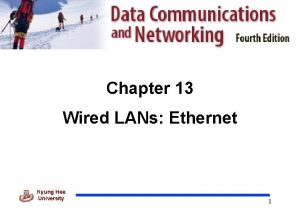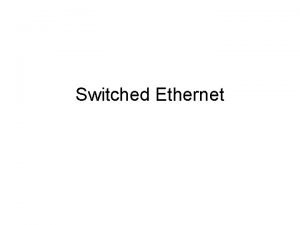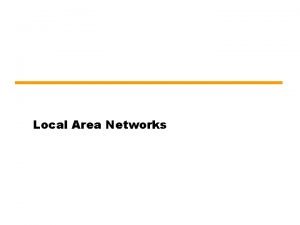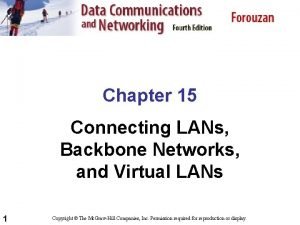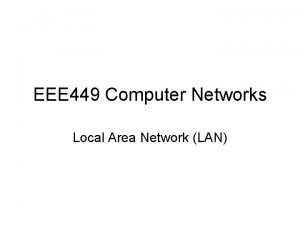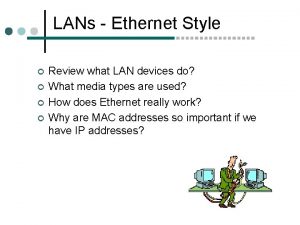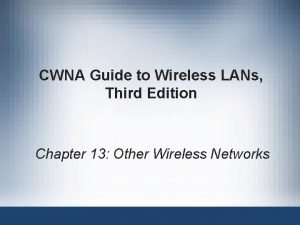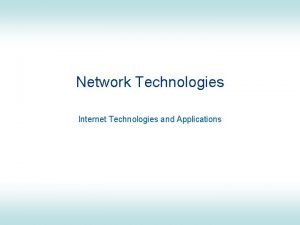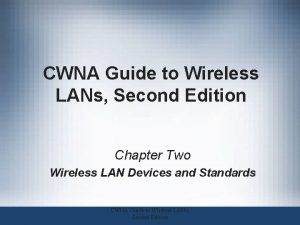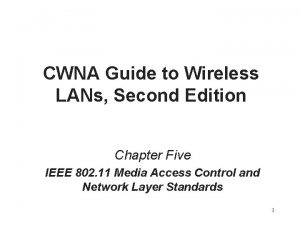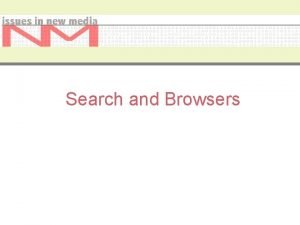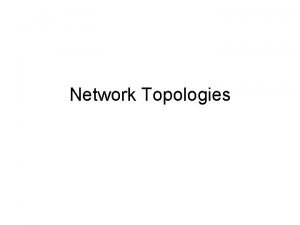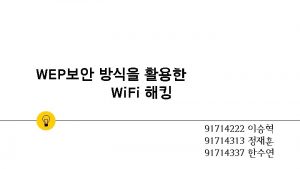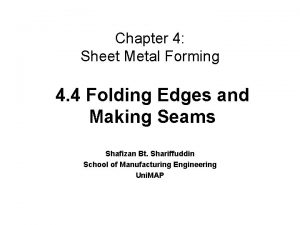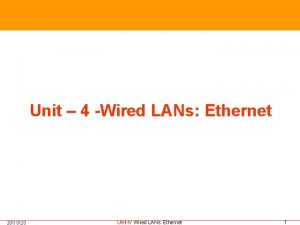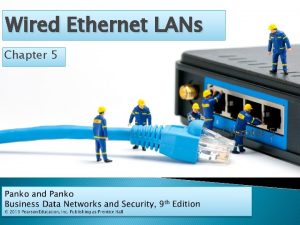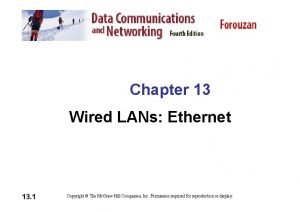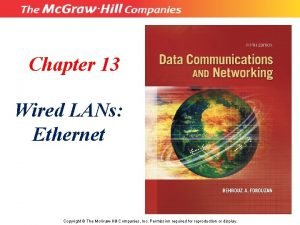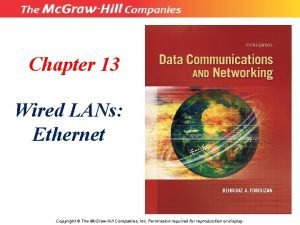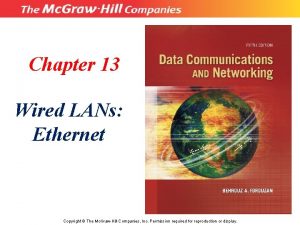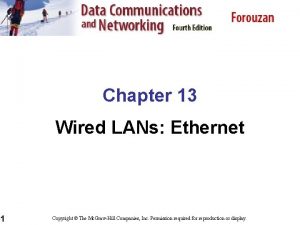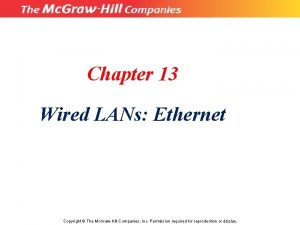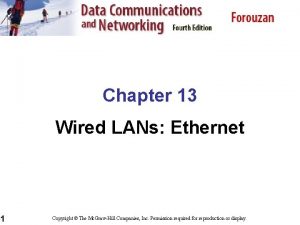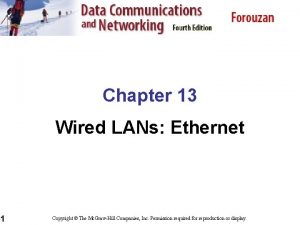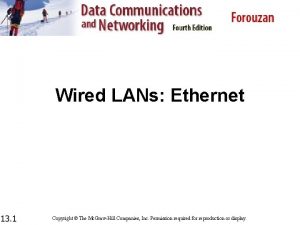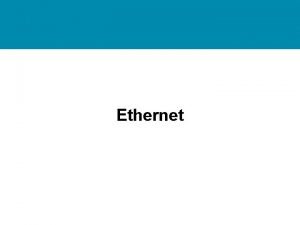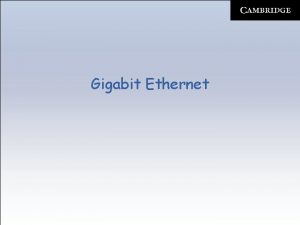Chapter 13 Wired LANs Ethernet Copyright The Mc


















- Slides: 18

Chapter 13 Wired LANs: Ethernet Copyright © The Mc. Graw-Hill Companies, Inc. Permission required for reproduction or display.

Chapter 5: Outline 13. 1 ETHERNET PROTOCOL 13. 2 STANDARD ETHERNET 13. 3 FAST ETHERNET 13. 4 GIGABIT ETHERNET 13. 5 10 GIGABIT ETHERNET

13 -1 ETHERNET PROTOCOL The data-link layer and the physical layer are the territory of the local and wide area networks. This means that when we discuss these two layers, we are talking about networks that are using them. 13. 3

13. 1 IEEE Project 802 In 1985, the Computer Society of the IEEE started a project, called Project 802, to set standards to enable intercommunication among equipment from a variety of manufacturers. Project 802 does not seek to replace any part of the OSI model or TCP/IP protocol suite. Instead, it is a way of specifying functions of the physical layer and the data-link layer of major LAN protocols. The relationship of the 802 Standard to the TCP/IP protocol suite is shown in Figure 13. 4

13. 1 IEEE Project 802 IEEE divided the Data link layer into two sublayer: Ø upper layer : logical link control (LLC); flow and error control. Ø Lower sublayer : Multiple access (MAC); media access control. v Multiple access (MAC) : for resolving access to the shared media. v If channel is dedicated ( point to point) we do not need the (MAC); sublayer.

Figure 13. 1: IEEE standard for LANs 13. 6

LLC (Logical link control)and MAC (Media Access Control) Ø In IEEE project 802, flow control , error control, and part of the framing duties are collected into one sublayer called the logical link control (LLC ) Ø LLC provides one single data link control for all IEEE LANs. Ø IEEE project 802 has created a sublayer. MAC that defines the specific access method for each LAN. In contrast to the LLC, MAC contains a number of distinct modules: each defines the access method and the framing format specific to the corresponding LAN protocol For example: • CSMA/CD as media access method for Ethernet LANs. • Token passing method for Token Ring and Token

ETHERNET Evolution

Figure 13. 2 : Ethernet evolution 13. 9

13 -2 STANDARD ETHERNET We refer to the original Ethernet technology with the data rate of 10 Mbps as the Standard Ethernet. Although most implementations have moved to other technologies in the Ethernet evolution, there are some features of the Standard Ethernet that have not changed during the evolution. We discuss this standard version first. 13. 10

13. 2. 1 Characteristics Let us first discuss some characteristics of the Standard Ethernet. • Connectionless and unreliable service • Frame format: • Frame length: • Minimum: 64 bytes (512 bits) • Maximum: 1518 bytes (12, 144 bits) 13. 11

Frame format The Ethernet frame contains seven fields: • Preamble: 7 bytes (56 bits); Alternating 0 s and 1 s, used for synchronizing • Start Frame Delimiter (SFD): 10101011 indicates the start of the frame. Last two bits (11) alerts that the next field is destination address. • preamble and SFD are added at the physical layer and is not formally part of the frame • Destination Address (DA): Destination address • Source Address (SA): Source Address • Type: Define the upper-layer protocol using the MAC frame. OR define the number of bytes in the data filed. • Data: minumum: 46 and maximum : 1500 bytes • CRC: error detection information: CRC-32 13. 12

Figure 13. 3: Ethernet frame • Minimum data length: 46 bytes • Maximum data length : 1500 bytes 13. 13

Example 13. 1 Show the address 47: 20: 1 B: 2 E: 08: EE is sent out online. Solution The address is sent left to right, byte by byte; for each byte, it is sent right to left, bit by bit, as shown below: 13. 14

13. 2. 2 Addressing Each station on an Ethernet network (such as a PC, workstation, or printer) has its own network interface card (NIC). The NIC fits inside the station and provides the station with a link-layer address. The Ethernet address is 6 bytes (48 bits), normally written in hexadecimal notation, with a colon between the bytes. For example, the following shows an Ethernet MAC address: 13. 15

Figure 13. 4: Unicast and multicast addresses • Source address is always a unicast address –the frames comes from only one station. • Destination address can be: • unicast: defines only one recipient; one to one • multicast: a group of addresses; one to many • Broadcast: the recipients are all the stations on the LAN 13. 16

Example 13. 2 Define the type of the following destination addresses: a. 4 A: 30: 10: 21: 10: 1 A b. 47: 20: 1 B: 2 E: 08: EE c. FF: FF: FF: FF Solution To find the type of the address, we need to look at the second hexadecimal digit from the left. If it is even, the address is unicast. If it is odd, the address is multicast. If all digits are Fs, the address is broadcast. Therefore, we have the following: 13. 17

Example 13. 2 (continued) a. This is a unicast address because A in binary is 1010 (even). b. This is a multicast address because 7 in binary is 0111 (odd). c. This is a broadcast address because all digits are Fs in hexadecimal. 13. 18
 Four generations of ethernet
Four generations of ethernet Unicast
Unicast Switched ethernet vs shared ethernet
Switched ethernet vs shared ethernet Tenth chapter wired
Tenth chapter wired High speed lans
High speed lans Network that allows several lans to be connected is
Network that allows several lans to be connected is Lans
Lans Lans style
Lans style Cwna guide to wireless lans 3rd edition
Cwna guide to wireless lans 3rd edition Internet technologies and applications
Internet technologies and applications Show that the maximum efficiency of pure aloha is 1/(2e)
Show that the maximum efficiency of pure aloha is 1/(2e) Adam lans
Adam lans Cwna guide to wireless lans
Cwna guide to wireless lans Cwna guide to wireless lans
Cwna guide to wireless lans Steven levy wired
Steven levy wired Star wired bus topology
Star wired bus topology Wired media and wireless media
Wired media and wireless media Wired equivalent privacy
Wired equivalent privacy Locked seam joint
Locked seam joint
